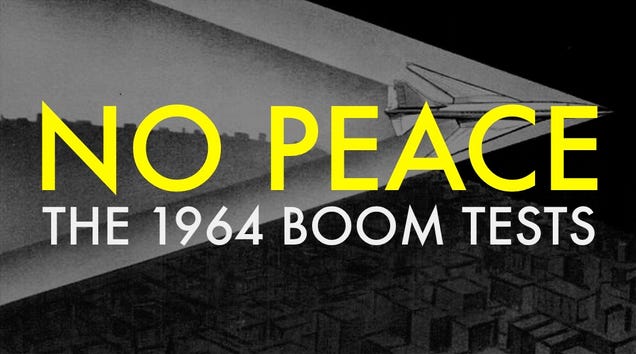
Have you ever experienced a sonic boom? A sonic boom so forceful that your dishes fell from the cupboards, your photos fell off the walls, and maybe your ceiling even started to crack? This was the reality that residents of Oklahoma City endured for six months in 1964 — eight times per day.
And they had absolutely no choice in the matter. Because it was all bought and paid for by the US government.
David Suisman, an Associate Professor of History at the University of Delaware, has a new paper on the 1964 Oklahoma City sonic boom tests. And he paints a picture of an American city terrorized by what the government billed as “the sound of freedom.”
Operation Bongo Comes to Oklahoma
In February of 1964 the Air Force and FAA started a six month bombardment campaign against the residents of Oklahoma City. It was called Operation Bongo II, and it meant that eight times per day people were inundated with sonic booms — shock waves made by Air Force planes flying faster than the speed of sound. The good folks of Oklahoma City were effectively guinea pigs for what was being tested as the high-speed transportation alternative of the future: Supersonic transportation (SST).
“The boom is particularly terrifying because it is louder than a thunderclap and comes out of a clear sky without warning,” Popular Mechanics wrote in 1964, reporting from Oklahoma. “For that reason, the Air Force, in scheduling its obviously needed practice runs, makes every effort to forewarn citizens in areas where booms can be anticipated.”
Well, yes and no. Residents of Oklahoma City got a warning, but they essentially only got it once. “The residents had no say in the matter,” David Suisman tells me over the phone. Which is kind of hard to imagine for those of us here in the early 21st century.
Over those six months, 1,253 supersonic flights were conducted using F-101s and F-104s, taking off from nearby Tinker Air Force Base. And the only thing residents knew for certain was that they’d happen eight times a day.
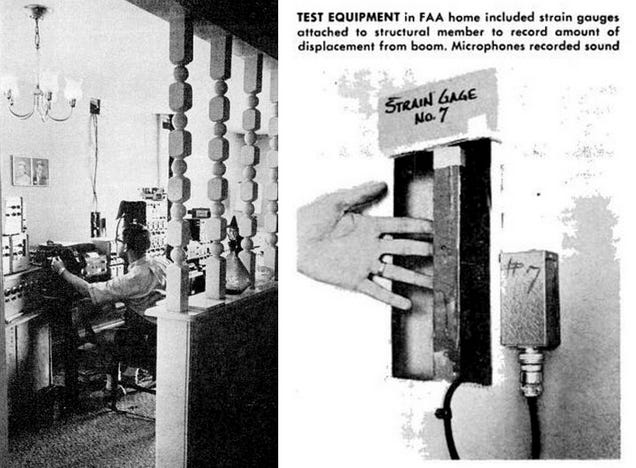
FAA test equipment from the October 1964 issue of Popular Mechanics
The FAA rented eleven buildings in and around Oklahoma City, all outfitted with high-tech equipment for measuring the sonic booms. One home that was sitting directly under the flight path contained about $100,000 worth of recording instruments. Mobile van units were also on call and placed throughout the city.
Over the course of those six months the flights would become faster and faster, causing more damage and noise. Just as residents were getting used to the force and semi-regularity of getting blasted eight times per day, the Air Force would hit them with an even harder shock.
Why Oklahoma City?
The tests of the 1960s have to be understood within the context of the Cold War. The controversy surrounding sonic booms in America didn’t begin in Oklahoma City, nor did they start in 1964. Residents near Air Force bases of the 1950s filed numerous complaints about the noisy disturbances that had emerged around them following the second World War. Many Americans felt that “the war” was over and were unexcited about the prospect of some state of perpetual war readiness necessitated by an ideological battle with the Soviets.
In response to both noise complaints and skeptics of Cold War tactics, the government produced short films and participated in the production of major Hollywood movies. Many of these critics were veterans, like in Jimmy Stewart’s fictionalized 1955 movie Strategic Air Command. The films sought to explaining why America’s war planes (and their noise) were all important tools in keeping us safe. Though Stewart starts out as a skeptic, he comes to realize that those noisy planes really were the sound of freedom and safety.
Sometimes safety meant you had to break a few windows. Like in the Chicago window fronts below, in 1958 photos taken after a sonic boom shattered windows in the city.
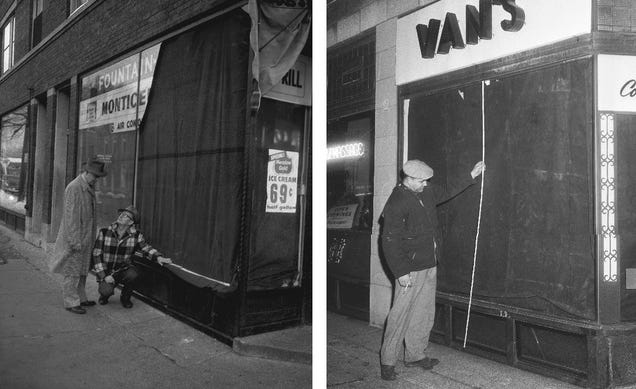
Photos from 1958 showing damage of Chicago businesses in the Chicago Sun-Times, courtesy of David Suisman
By the early 1960s the likelihood of the government and private industry both getting involved in carrying civilians by supersonic transport was looking more and more likely. So the Kennedy administration tasked the FAA with devising real world tests to see how Americans on the ground might react.
There were other more limited tests done on the residents of Chicago and St. Louis in the 1960s. But none were quite as extensive as the Oklahoma tests, which lasted for half a year. It seems as though Oklahoma City was ultimately chosen for the tests because much of Oklahoma City’s population was employed by the aerospace industry.
“I think the fact that Oklahoma City was a big aerospace city mattered quite a bit,” Suisman told me. “The number of people who worked in the aerospace industry or knew somebody who worked in the aerospace industry was quite high. There was significant buy-in in the population already from the point of the FAA, which was hoping for favorable results.”
Damage and Public Reaction
The FAA hired a public polling research firm to determine how the city’s roughly 500,000 residents took to the tests. During the six months of the test, the Air Force and FAA received over 15,000 formal complaints from the residents of Oklahoma City. They also received 4,629 official damage claims.
The high number of damage claims likely came as no surprise to government officials. From 1956 until 1963 the Air Force had over 14,000 claims for damage leveled against it.
As Suisman points out, some of the public polling numbers from the time are actually surprising. While a full 40 percent of Oklahoma City resident polled felt that their homes had been damaged in some way, 73 percent said that they could live just fine with eight sonic booms per day. Again, the city’s reliance on the aerospace industry might have had something to do with this attitude.
The Oklahoma tests may have been the most long lasting, but they weren’t the first nor the last. In 1961-62, the FAA conducted 150 supersonic flights over St. Louis. Those tests yielded about 5,000 formal complaints and 1,624 damage claims. Chicago also saw sonic boom tests, with 49 flights rippling through Chicagoland in 1965. Those tests saw an even greater number of complaints per test, with 7,116 formal complaints filed with the FAA. The Chicago tests also saw a huge number of damage claims, with 2,964 filed during the short test period.
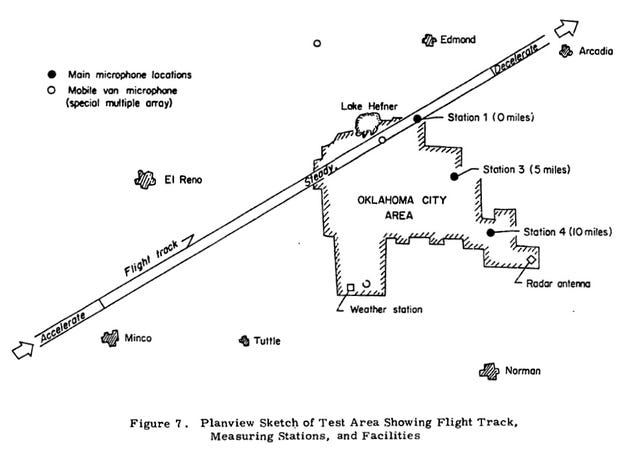
Test flight map from a 1965 report prepared for the FAA
Residents who took issue with the sonic boom tests of the 1960s had little in the way of recourse. What little they could do involved plenty of paperwork. The burden of proof was decidedly on the residents to demonstrate that the sonic boom had caused damage to their property.
One resident of Madison, Illinois filed an official damage report for a $6 vase. He had to fill out 18 pages of forms including a three-page explanation of how the government’s sonic boom was the cause of the damage, and not anything else. Witness testimony, certificate of ownership and insurance information were among the other documents that had to be filed. Many people probably didn’t think it was worth all the trouble.
Sound As a Weapon
While the stated purpose of the tests was to conduct experiments that would be helpful for civilian use of SST, there was certainly a military component. It was, after all, the military that conducted the tests.
“On the one hand, you have parts of the government like the FAA and the Air Force which were publicly saying that sonic booms were, in their language ‘the sound of freedom’ and they represented a part of the national defense that was vital to security of the country in the context of the cold war,” Suisman tells me. “However, they were also said to be harmless for the sake of the population who would be affected by sonic booms.”
How could the booms be both perfectly safe for Americans and a potential weapon in war? You’d have to ask the Air Force that one.

Dept of Defense anti-Castro planning document from 1962 describing Operation Invisible Bomb
“They were sort of couched in this language of being vital to the national defense, yet harmless,” Suisman says. “On the other hand, there was also at the same time movement in the government to do these tests to figure out whether or not sonic booms could be used as tactical weapons.”
The brainstorming sessions of the Defense Department in the early 1960s are a perfect example of the thinking around how sonic booms might be used against a foreign enemy.
“There were several tests conducted to this end, and one of them resulted in the proposal of Operation Invisible Bomb, which was an idea to use the sonic booms to foment chaos in Cuba.”
You read that right. American military planners wanted to inundate Cuba with sonic booms to make Cubans think that they were under attack. And even if the Air Force only used sonic booms, they very much would be. So would tomorrow’s use of sonic booms be used for war or peace? A bit of both, it would seem.
The Future is Inevitable?
Supersonic transportation was seen as the wave of the future. Or at the very least that’s how it was being sold to the American public. Imagine flying from New York to San Francisco in just a half hour!, government and industry boosters wondered aloud. Or New York to London in just two hours! By the 1950s the US military had developed the necessary high-speed technology. And by the late 1960s it was civilian carriers who were promising they’d soon shuttle Americans at supersonic speed all around the globe.
To be against the SST was to be against the arrival of The Future™. The President of the Air Transport Association of America, Stuart Tipton, painted opposition to the SST as silly, old fashioned romantics pining for an age that had long since passed.
“Who would give up Salk vaccine for the five-cent stein of beer?” Tipton wondered in a 1964 speech. “Who would turn back the X-ray machine for the old swimming hole?”
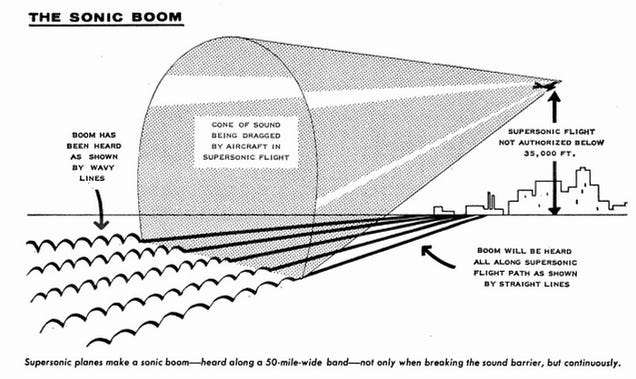
Illustration from an Air Force pamphlet explaining sonic booms
The future (and by extension the arrival of SST) was “inevitable.” Or at least that’s how the aerospace industry was selling it. John E. Stephen, again from the Air Transport Association, described SST as the “next inevitable advance in the technology of commercial air transportation.” And what good is it to fight the inevitable?
Our aerospace future was arriving, and every other field of technology would have to catch up. Beginning with architecture. For those people who complained that the sonic booms were harming their homes and businesses, pro-boom advocates pointed out that their buildings were old. The implication was that these people with old buildings should get with the times; that it was their own fault if their homes were falling apart from the shock waves that tore through the city.
Popular Mechanics even published the somewhat counterintuitive illustration below, showing what the boom-proof houses of the future should look like. Those circular buildings which had become all the rage as extremely modern, streamlined, and chic? Ironically, those would have to go.

Illustration from the October 1964 issue of Popular Mechanics
Silence or Something Close
The last day of the tests in Oklahoma was July 31, 1964. And even though the FAA had evidence that residents of Oklahoma City could at least tolerate sonic booms indefinitely, the tide was turning against noise. The broader American public was growing tired of what they saw as an increasingly noisy world.
“One of the things that emerges in the late 1960s is this language of noise pollution,” Suisman says. “And sonic booms are part of the argument against having uncontrolled noise as an environmental factor. And when the environmental movement gets going in the early 1970s, noise pollution is one of its concerns.”
By 1971, expansion of civilian supersonic transport was effectively killed in the United States. The Concorde would zip across the Atlantic Ocean at supersonic speed, but the American public simply had no patience for SST planes bouncing from city to city, leaving jolted people in their wake.
The 1964 Oklahoma City experiments were meant to be a proving ground for the transportation of tomorrow — proof that the future could be tolerated, if not adored. But if they proved anything, it was that the future actually isn’t inevitable. The future is what we make it. And for the time being, that future has far fewer supersonic aircraft than the people of the 1960s imagined.
from ffffff http://paleofuture.gizmodo.com/when-the-faa-blasted-oklahoma-city-with-sonic-booms-for-1649589210/+kcampbelldollaghan
via IFTTT







0 comentarios:
Publicar un comentario